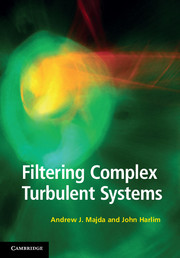Book contents
- Frontmatter
- Contents
- Preface
- 1 Introduction and overview: Mathematical strategies for filtering turbulent systems
- Part I Fundamentals
- Part II Mathematical guidelines for filtering turbulent signals
- Part III Filtering turbulent nonlinear dynamical systems
- 9 Strategies for filtering nonlinear systems
- 10 Filtering prototype nonlinear slow–fast systems
- 11 Filtering turbulent nonlinear dynamical systems by finite ensemble methods
- 12 Filtering turbulent nonlinear dynamical systems by linear stochastic models
- 13 Stochastic parametrized extended Kalman filter for filtering turbulent signals with model error
- 14 Filtering turbulent tracers from partial observations: An exactly solvable test model
- 15 The search for efficient skillful particle filters for high-dimensional turbulent dynamical systems
- References
- Index
14 - Filtering turbulent tracers from partial observations: An exactly solvable test model
from Part III - Filtering turbulent nonlinear dynamical systems
Published online by Cambridge University Press: 05 March 2012
- Frontmatter
- Contents
- Preface
- 1 Introduction and overview: Mathematical strategies for filtering turbulent systems
- Part I Fundamentals
- Part II Mathematical guidelines for filtering turbulent signals
- Part III Filtering turbulent nonlinear dynamical systems
- 9 Strategies for filtering nonlinear systems
- 10 Filtering prototype nonlinear slow–fast systems
- 11 Filtering turbulent nonlinear dynamical systems by finite ensemble methods
- 12 Filtering turbulent nonlinear dynamical systems by linear stochastic models
- 13 Stochastic parametrized extended Kalman filter for filtering turbulent signals with model error
- 14 Filtering turbulent tracers from partial observations: An exactly solvable test model
- 15 The search for efficient skillful particle filters for high-dimensional turbulent dynamical systems
- References
- Index
Summary
Turbulent diffusion is a physical process that describes the transport of a tracer in a turbulent velocity field. Very often the tracer itself has very little or no influence on the background flow, in which case it is referred to as a passive tracer. Practically important examples include engineering problems such as the spread of hazardous plumes or pollutants in the atmosphere and contaminants in the ocean. Another class of problems that involve turbulent diffusion are climate science problems concerning the transport of greenhouse gases such as carbon dioxide and others. One of the characteristics of these systems is their complex multi-scale structure in both time and space. For example, the spatial scales of atmospheric flows span from planetary-scale Rossby waves to local weather patterns with the size of kilometers. Similarly, temporal scales involve both slow dynamics on the scales of decades as well as the fast dynamics on the scales of hours. Another remarkable property of many tracers in the atmosphere is their highly intermittent probability distributions with long exponential tails (Neelin et al., 2011). Many contemporary applications in science and engineering involve real-time filtering of such turbulent non-Gaussian signals from nature with multiple scales in time and space.
Real-time tracking of a chemical plume released into the atmosphere or a contaminant injected into the ocean is another extremely important and practical example where real-time data assimilation plays a crucial role.
- Type
- Chapter
- Information
- Filtering Complex Turbulent Systems , pp. 276 - 315Publisher: Cambridge University PressPrint publication year: 2012



